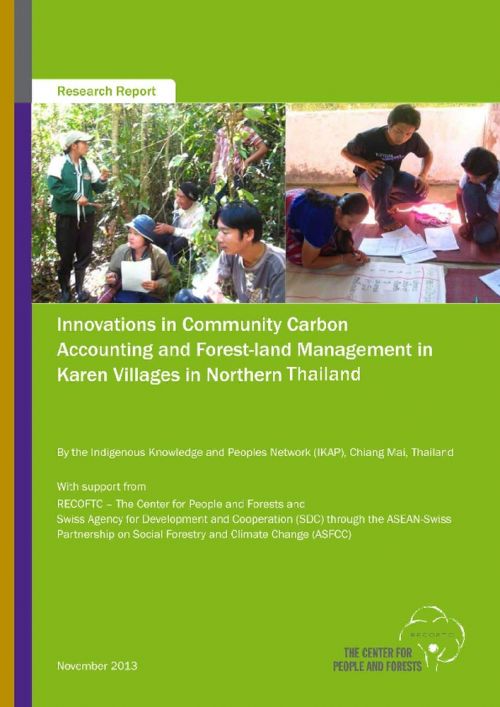APA 6th ed. Innovations in Community Carbon Accounting and Forest-land Management in Karen Villages in Northern Thailand. (2014, June 1). Retrieved from https://www.recoftc.org/publications/0000189
MLA 8th ed. Innovations in Community Carbon Accounting and Forest-land Management in Karen Villages in Northern Thailand. RECOFTC, 1 June 2014, https://www.recoftc.org/publications/0000189.
Chicago 17th ed. RECOFTC. 2014. "Innovations in Community Carbon Accounting and Forest-land Management in Karen Villages in Northern Thailand." Published June 1, 2014. https://www.recoftc.org/publications/0000189.
Innovations in Community Carbon Accounting and Forest-land Management in Karen Villages in Northern Thailand

In Southeast Asia, shifting cultivation is still predominantly practiced by the poorest segment of the population. Around 40 million people living in forest-agricultural lands from the ASEAN countries still depend considerably on shifting cultivation, also referred to as swidden farming and rotational farming, for income and livelihoods. Traditionally considered as a sustainable practice, it is now fast becoming one of the causes of forest degradation.
To address this, a research was conducted to develop methods for integrating simple scientific techniques with indigenous knowledge and best practices on locally appropriated adaptation and mitigation actions (LAAMAs) in forest land management and to initiate integrated forest-land-carbon management in two indigenous communities in Northern Thailand.
The research was conducted in Ban Mae Lan Kham Karen Village from October 2012 to October 2013. Mae Lan Kham is a Pgaz K ’Nyau community located at Moo 6 Samoeng Tai Sub-district, Samoeng District, Chiang Mai, composed of five village clusters with a population of 658.
The research used the participatory action research technique for studying both indigenous knowledge in forest land management and carbon stock accounting.
In terms of indigenous knowledge and practices, the study revealed that sacred sites or conserved forest areas based on people’s beliefs can be classified into three types:
- Areas with restrictive ecological characteristics based on Pgaz K’ Nyau beliefs;
- Areas with ancient ruins; and
- Holy forest for ritual practice
The study also yielded several strategies for adaptation on natural resource management using low carbon technique such as soil restoration using bamboos; and fallow restoration to increase biodiversity.
In general, the body of knowledge on ecology related to the way of life of the Pgaz K’ Nyau is a result of accumulated experiences in ecological management spanning several generations, and extracted in the form of TajDuf (constraining rules) based on beliefs that regulate the relationship between people and ecological system.
While in carbon stock accounting, the study found that rotational farming with a cycle of eight years is likely to maintain the balance of carbon storage and carbon emission from slash-and-burn. The effective carbon management such as the use of wood without burning helps reduce emission, leading to carbonbalanced communities and stock enhancement. Hence, the rotational cropping field with carbonbalanced cycle must be promoted.
Community members recommend to make a reliable and accurate map of all the sacred sites and toenforce the rules and regulations in each site; and to revitalize the traditional rituals and activities and to modify them to fit the present context where necessary. Researchers recommend conducting further study in the permanent plot to generate clearer data, especially the accumulation of carbon quantity in rotational fields of each age class.
Navigate to the ASEAN-Swiss Partnership on Social Forestry and Climate Change (ASFCC) page

